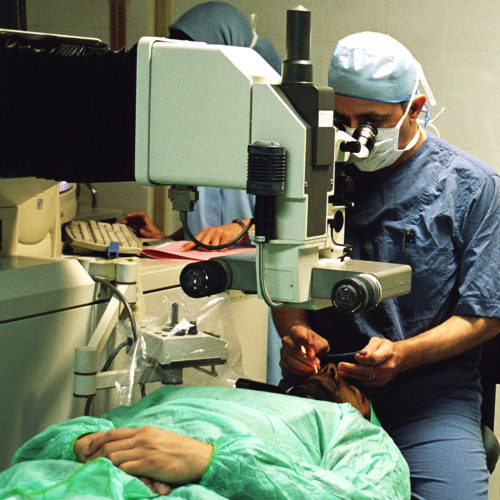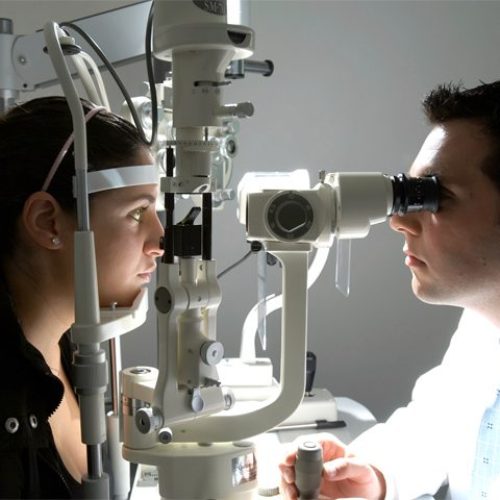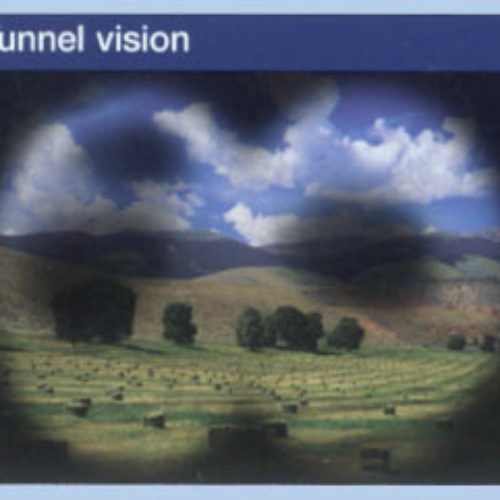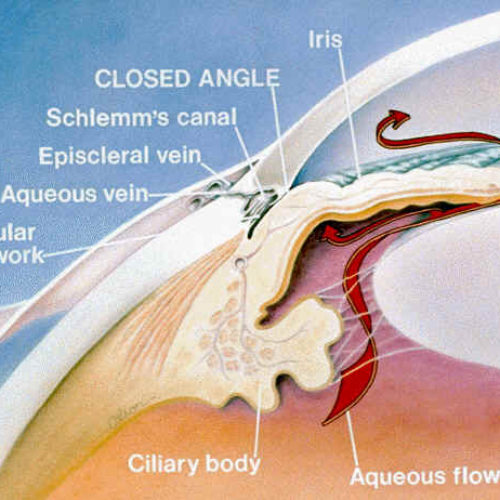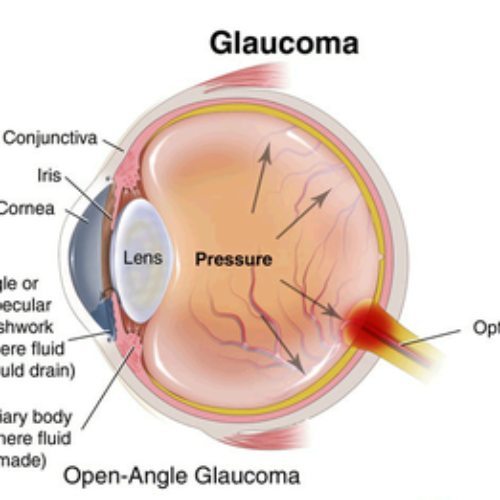Glaucoma
Glaucoma
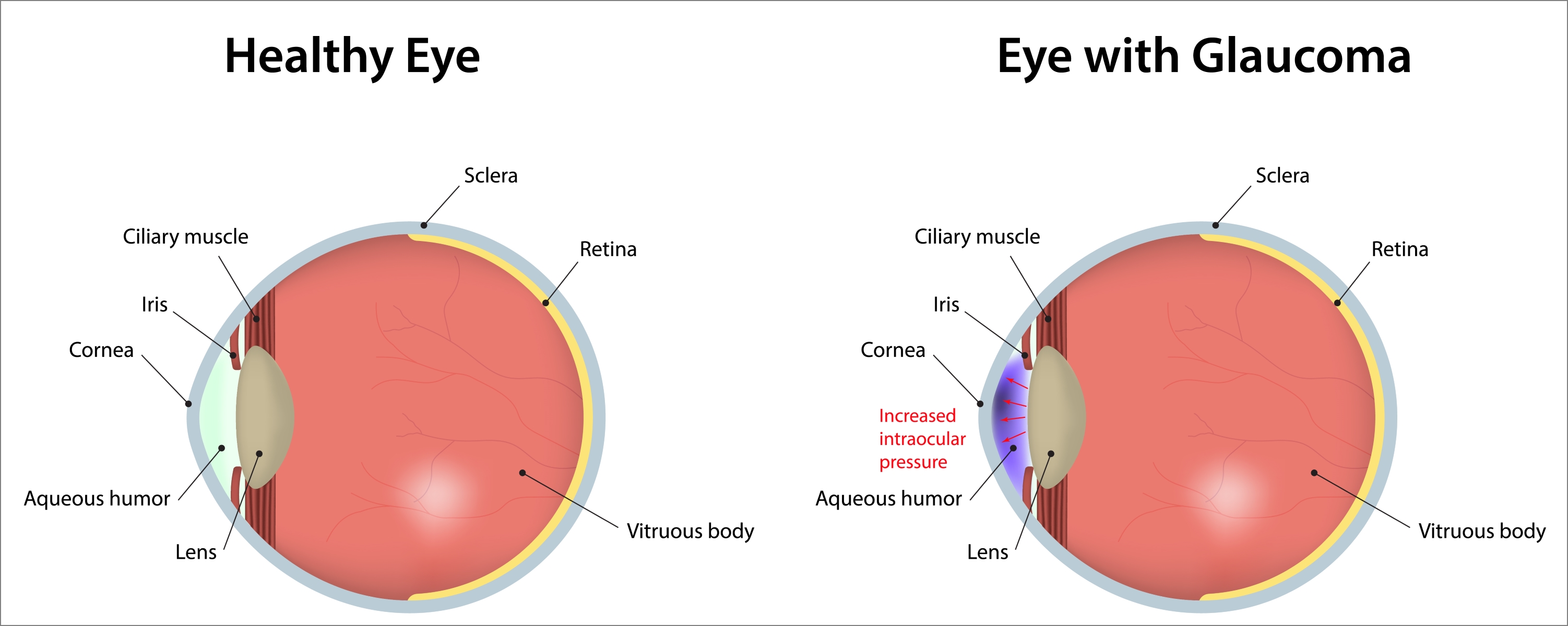
Glaucoma is a condition that causes damage to your eye’s optic nerve and gets worse over time. It’s often associated with a buildup of pressure inside the eye. Glaucoma tends to be inherited and may not show up until later in life.
The increased pressure, called intraocular pressure, can damage the optic nerve, which transmits images to the brain. If damage to the optic nerve from high eye pressure continues, glaucoma will cause permanent loss of vision. Without treatment, glaucoma can cause total permanent blindness within a few years.
Because most people with glaucoma have no early symptoms or pain from this increased pressure, it is important to see your eye doctor regularly so that glaucoma can be diagnosed and treated before long-term visual loss occurs.
If you are over age 40 and have a family history of glaucoma, you should have a complete eye exam with an eye doctor every one to two years. If you have health problems such as diabetes or a family history of glaucoma or are at risk for other eye diseases, you may need to visit your eye doctor more frequently.
Why Does Pressure Rise in the Eye to Cause Glaucoma?
Glaucoma usually occurs when pressure in your eye increases. This can happen when eye fluid isn’t circulating normally in the front part of the eye.
Normally, this fluid, called aqueous humor, flows out of the eye through a mesh-like channel. If this channel becomes blocked, fluid builds up, causing glaucoma. The direct cause of this blockage is unknown, but doctors do know that it can be inherited, meaning it is passed from parents to children.
Less common causes of glaucoma include a blunt or chemical injury to the eye, severe eye infection, blockage of blood vessels in the eye, inflammatory conditions of the eye, and occasionally eye surgery to correct another condition. Glaucoma usually occurs in both eyes, but it may involve each eye to a different extent.
What Are the Types of Glaucoma?
There are two main types of glaucoma:
Open-angle glaucoma
Also called wide-angle glaucoma, this is the most common type of glaucoma. The structures of the eye appear normal, but fluid in the eye does not flow properly through the drain of the eye, called the trabecular meshwork.
Angle-closure glaucoma
Also called acute or chronic angle-closure or narrow-angle glaucoma, this type of glaucoma is less common in the West than in Asia. Poor drainage is caused because the angle between the iris and thecornea is too narrow and is physically blocked by the iris. This condition leads to a sudden buildup of pressure in the eye
Who Gets Glaucoma?
Glaucoma most often occurs in adults over age 40, but it can also occur in young adults, children, and even infants. In African-Americans, glaucoma occurs more frequently and at an earlier age and with greater loss of vision.
You are at an increased risk of glaucoma if you:
- Are of African-American, Irish, Russian, Japanese, Hispanic, Inuit, or Scandinavian descent
- Are over age 40
- Have a family history of glaucoma
- Have poor vision
- Have diabetes
- Take certain steroid medications, such as prednisone
- Have had trauma to the eye or eyes
What Is the Outlook for People With Glaucoma?
At this time, loss of vision caused by glaucoma is irreversible and cannot be restored. However, successfully lowering eye pressure can help prevent further visual loss from glaucoma. Most people with glaucoma do not go blind if they follow their treatment plan and have regular eye exams.
What Are the Symptoms of Glaucoma?
For most people, there are usually few or no symptoms of glaucoma. The first sign of glaucoma is often the loss of peripheral or side vision, which can go unnoticed until late in the disease. This is why glaucoma is often called the “sneak thief of vision.”
Detecting glaucoma early is one reason you should have a complete exam with an eye specialist every one to two years. Occasionally, intraocular pressure can rise to severe levels. In these cases, sudden eye pain, headache, blurred vision, or the appearance of halos around lights may occur.
If you have any of the following symptoms, seek immediate medical care:
- Seeing halos around lights
- Vision loss
- Redness in the eye
- Eye that looks hazy (particularly in infants)
- Nausea or vomiting
- Pain in the eye
- Narrowing of vision (tunnel vision)
How Is Glaucoma Diagnosed?
To diagnose glaucoma, an eye doctor will test your vision and examine your eyes through dilated pupils. The eye exam typically focuses on the optic nerve, which has a particular appearance in glaucoma. In fact, photographs of the optic nerve can also be helpful to follow over time as the optic nerve appearance changes with the progression of the disease. The doctor will also perform a procedure called tonometry to check for eye pressure, and a visual field test, if necessary, to determine if there is loss of side vision. Glaucoma tests are painless and take very little time.
Can Glaucoma Be Prevented?
Glaucoma cannot be prevented, but if it is diagnosed and treated early, the disease can be controlled.
How Is Glaucoma Treated?
Glaucoma treatment may include prescription eye drops, laser surgery, or microsurgery.
- Eye drops for glaucoma
These either reduce the formation of fluid in the front of the eye or increase its outflow. Side effects of glaucoma drops may include allergy, redness of the eyes, brief stinging, blurred vision, and irritated eyes. Some glaucoma drugs may affect the heart and lungs. Be sure to tell your doctor about any other medications you are currently taking or are allergic to.
- Laser surgery for glaucoma
Laser surgery for glaucoma slightly increases the outflow of the fluid from the eye in open-angle glaucoma or eliminates fluid blockage in angle-closure glaucoma. Types of laser surgery for glaucoma include trabeculoplasty, in which a laser is used to pull open the trabecular meshwork drainage area; iridotomy, in which a tiny hole is made in the iris, allowing the fluid to flow more freely; and cyclophotocoagulation, in which a laser beam treats areas of the middle layer of the eye, reducing the production of fluid.
- Microsurgery for glaucoma
In an operation called a trabeculectomy, a new channel is created to drain the fluid, thereby reducing intraocular pressure that causes glaucoma. Sometimes this form of glaucoma surgery fails and must be redone. For some patients, a glaucoma implant is the best option. Other complications of microsurgery for glaucoma include some temporary or permanent loss of vision, as well as bleeding or infection.
Open-angle glaucoma is most commonly treated with various combinations of eye drops, laser trabeculoplasty, and microsurgery. Traditionally in the U.S., medications are used first, but there is increasing evidence that some people with glaucoma may respond better with early laser surgery or microsurgery.
Infant or congenital glaucoma meaning you are born with it is primarily treated with surgery, because the cause of the problem is a very distorted drainage system.
Talk to your eye doctor to find out which glaucoma treatment is right for you
Persian International Health Tourism is a private company act as a facilitator between patients/visitors, best medical teams and various hospitals suggesting best available options based on your required treatment or other services.





